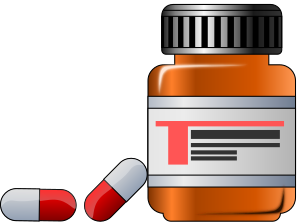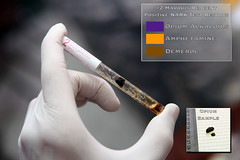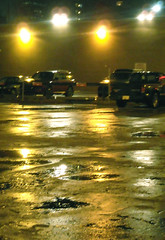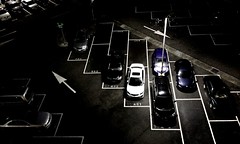___________________________________________________________________________________
| (Photo credit: Wikipedia) |

EXCERPT FROM MISSING LYNX - Book Two
We watched the monitor closely; the robot stood flush with the case. A pincer reached out to twirl the locking system, using the combination that I had uncovered while behind the Veil. The mechanical arm moved with amazing dexterity, slowly releasing the catch, retrieving the papers and files. Axel wiggled the toggle and the robot zipped back to us with the booty. Again Axel maneuvered the machine to the case. The robot sent a video image to our laptop; I studied the screen until I could show Axel where the concealed latch protected the hidden compartment. We all held our breath while Axel maneuvered the motorized claw to release the hook.
***
The following information was gathered from bomb squad members that I met at this year's Writers' Police Academy. Because of their undercover work, neither their names nor images can be used in this article. A bomb squad member is also called an EOD (Explosive Ordinance Disposal) Technician. All EOD Techs come through the Redstone Arsenal in Huntsville, Alabama where they undergo an intensive 6 week training session.
* There are at least two people per responding team.
* Typically this team prefers nine members
* On this team, the EOD techs have other police duties and leave those duties to respond to bomb threats.
The Suit
Bomb Protective Suit is a little bit of a misnomer. Though it can help; it will not actually keep someone alive under all circumstances. What makes a difference in survivability?* How close is the officer?
* How big is the blast? The concussion of the blast can be as deadly as the shrapnel.
* At five feet from the bomb survivability increases by 50%

I am all suited up at the Writers' Police Academy 2013

I'd explain this to you, but then I'd... EOD Suit WPA 2013
VIDEO QUICK STUDY - suit and safety features (2:54)
THE SUIT
*Is made of various materials including Kevlar to prevent penetration and ceramic plates to help disperse the

 |
| Suit Components WPA 2012 |
* Cost? aprox 75k
* The suit weighs approximately 85-100 lbs.
35 lbs for the trousers
35 lbs. for the jacket
8 lbs. for the helmet
And boots.
This suits allows little in the way of dexterity and
agility. More armor might increase protection
but make movement impossible.
(Though this guy is going to prove me wrong: VIDEO QUICK STUDY - dancing in a EOD suit 2:17)
* The helmet includes a fan unit to help prevent humidity from building up inside of the visor. But
does not cool the person inside.
* The suit has no cooling unit - considering the weight of the suit, the body response to adrenaline and
physical activity, and the ambient temperature a bomb technician has about a twenty minute window
of operational opportunity.
* If there is a possibility of a contaminant or bio-hazard, the team members have access to special suits
that incorporate oxygen tanks (SCBA Self-contained Breathing Apparatus). These tanks add to the
weight and loss of agility. These usually have about 45 minutes of air. That time period must include time
to "decon" (decontaminate).
TOOLS-
VIDEO QUICK STUDY - Tools in use (3:53)
1. Telescopic manipulator - has a claw allowing a technician to work from a safer distance.
2. Ordinance disposal tools - the one we saw was approx. 35 lbs and could shoot the bomb. Also, there
are:
* robots with hooks, arms, car door openers, etc.
* water jet disruptors
| A Belgian Malinois of a police K-9 unit. (Photo credit: Wikipedia) |
3. Remote viewing systems that might include
* Borescopes
* Videoscopes
* Fiberscopes
* X-ray technology
4. Disruptors - can open up the package.
5. Bomb Detection Dogs
VIDEO QUICK STUDY (2:32)
* Dogs are typically taught to sit or lie down when
they detect the scent.
* Typically they are rewarded with a ball
* Dogs are trained to the base component of
explosives. Once they have these components
any combination will trigger an alert. Dogs smell
differently than humans if a human smells "stew," a
dog smells carrots, and beef and onion, etc.
 |
| WPA 2013 That's my scary backpack. I named the robot "Molly," because she needed a name. |
* Cost? Approx 125K and up
* Depending on model, these are around 44 lbs.
* VIDEO QUICK STUDY (3:41)
THIS IS EXCELLENT
* Major issue is depth perception. That's
why these techs practice, practice,
practice.
* Information is transmitted via wireless to
the HAZMAT truck
ASSESS, ASSESS, ASSESS
Video Quick Study British EOD Tech talking about the "Long Walk" and assessment (2:38)
For a bomb to go off there need to be three components:
1. Battery
2. Switch
3. High Explosive Charge
Disrupt any of these and you render the bomb inoperable.
Basic Techniques
(Techniques are kept secret so as not to train the attacker in better ways to succeed)VIDEO QUICK STUDY - Suspicious Package Investigation (9:02)
1. Determine that there is a possible event. In the case of the technicians I was interviewing, most of their
calls come from people who have found dynamite, or war souvenirs (WWII from granddad) and not
from actual concerns about a bomb.
 |
| WPA 2013 Bomb Extraction Truck |
* Mobile Headquarters with gear also called
HAZMAT Truck
* Containment Truck
* EMTs and fire
3. Clear the area to ensure the public's safety
* Set up equipment this might include tenting if
they believe bio-hazardous materials were
used.
4. Suit up
5. Develop intelligence
* They cannot use radio communication because it could set off the bomb.
6. Formulate a plan
7. Work the plan and leave.
* If they are exploding something they yell, "FIRE IN THE HOLE!" three times.
* Exploding the object is called "disrupting the device."
* Counter Charge - means to put another explosive device on top of the suspected bomb and blow it up
* Video Quick Study (4:50)
























